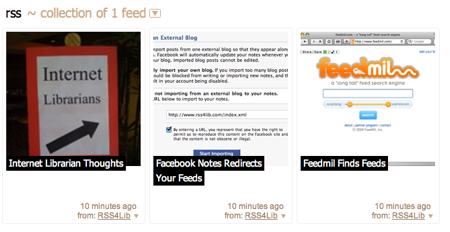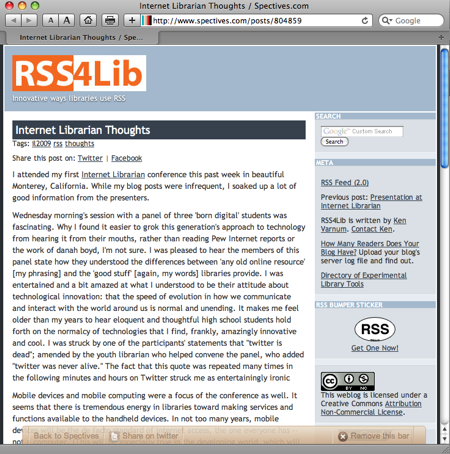I found a new tool (via a review at ReadWriteWeb) that offers a visual presentation of changing RSS feeds: Spectives, a “search for visual news.” Conceptually, it’s quite interesting. Its use of intellectual property is unfortunate.
Spectives is focused on visual content. It ignores plain text entries on a blog, highlighting those posts with images. I created a collection called RSS and added this blog’s feed to it; Spectives pulled in the most recent posts that included images:

Interestingly, Spectives ignores posts with embedded video (at least, the UStream feed embedded in a recent post on this blog).
Spectives’ front page offers a one-minute tutorial right up front — probably because the point of the tool is a bit vague, if intriguing — and then lists popular and featured collections. The “Nature Photography” collection (under featured) offers pictures from five photography feeds; the “Celebrities” collection pulls in feeds from 15 gossip/tabloid sites.
While the tool is interesting, its mechanism for getting users to the source content is highly annoying. Each collection (and search) comes with its own RSS feed that includes all the items in the source’s feed, not restricting it to images. Clicking to the full text of an item in the RSS feed takes you to the original site, which makes sense. However, Spectives puts a translucent toolbar across the bottom of the page with a link “Back to Spectives” and a link to share the post on Twitter — with a Spectives URL built in. Here’s a sample of my previous post, in its entirety, with a Spectives URL and my Creative Commons license, along with the Spectives toolbar.
At the moment, this is probably in technical compliance with the Creative Commons license — however, as the “advertise” link on the bottom of every Spectives web page indicates, the site is clearly trying to monetize other peoples’ content. In my opinion, Spectives’ reproduction of my entire web site separated from my URL crosses an ethical, if not legal, line. I am not a fan.

